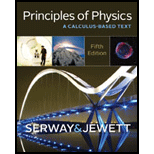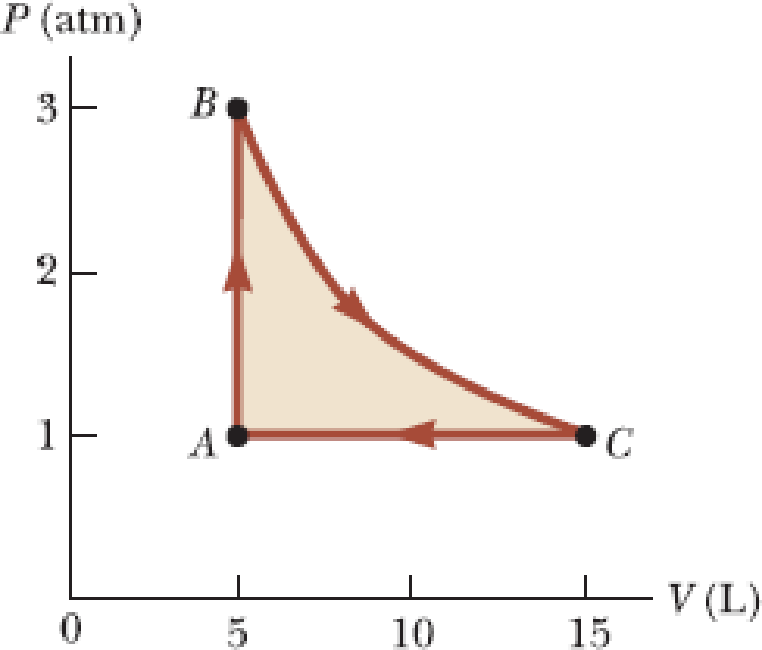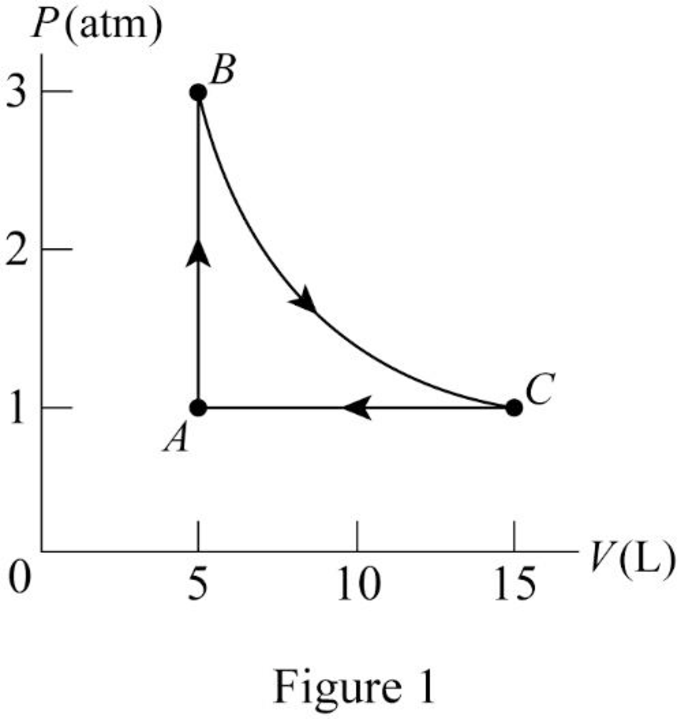
A sample of a monatomic ideal gas occupies 5.00 L at atmospheric pressure and 300 K (point A in Fig. P17.68). It is warmed at constant volume to 3.00 atm (point B). Then it is allowed to expand isothermally to 1.00 atm (point C) and at last compressed isobarically to its original state. (a) Find the number of moles in the sample. Find (b) the temperature at point B, (c) the temperature at point C, and (d) the volume at point C. (e) Now consider the processes A → B, B → C, and C → A. Describe how to carry out each process experimentally. (f) Find Q, W, and ΔEint for each of the processes. (g) For the whole cycle A → B → C → A, find Q, W, and ΔEint.
Figure P17.68

(a)
Thenumber of mole in the sample.
Answer to Problem 68P
Thenumber of mole in the sample is
Explanation of Solution
Write the expression for theideal gas law,
Here,
Rewrite the above equation,
Conclusion:
Substitute
Therefore, the number of mole in the sample is
(b)
The temperature of the sample at point
Answer to Problem 68P
The temperature of the sample at point
Explanation of Solution
Write the expression for thetemperature of the sample at point
Here,
Conclusion:
Substitute
Therefore, the temperature of the sample at point
(c)
The temperature of the sample at point
Answer to Problem 68P
The temperature of the sample at point
Explanation of Solution
Write the expression for thetemperature of the sample at point
Here,
Conclusion:
Substitute
Therefore, the temperature of the sample at point
(d)
The volume of the sample at point
Answer to Problem 68P
The volume of the sample at point
Explanation of Solution
Write the expression for thevolume of the sample at point
Here,
Conclusion:
Substitute
Therefore, the volume of the sample at point
(e)
Explain the processes
Answer to Problem 68P
In the process
In the process
In the process
Explanation of Solution
In the process
Lock the piston in place and put the cylinder into an oven at the temperature of
Here the gas is getting heat gradually.
In the process
The sample is keep in the oven while the gas expand gradually and to lift a load on the piston as far as it can.
In the process
The cylinder is carry and back into the room temperature at
Here the gas is cooling gradually and contract without touching the piston.

Conclusion:
Therefore, in the process
In the process
In the process
(f)
The value of
Answer to Problem 68P
The value of
Explanation of Solution
For
Write the expression for theenergy transferred by heat,
Here,
Write the expression for the change in internal energy,
In this case,
For
Write the expression for the work done on the sample,
In this case,
For
Write the expression for the work done on the sample,
Conclusion:
Substitute
Substitute
Substitute
Substitute
Substitute
Substitute
Substitute
Therefore, the value of
(g)
The value of
Answer to Problem 68P
The values of
Explanation of Solution
Write the expression for theenergy transferred by heat in the whole process
Write the expression for the work done for whole process,
Write the expression for the change in internal energy for whole process,
Conclusion:
Substitute
Substitute
Substitute
Therefore, the values of
Want to see more full solutions like this?
Chapter 17 Solutions
Principles of Physics
- A sample of a monatomic ideal gas occupies 5.00 L at atmospheric pressure and 300 K (point A in Fig. P21.65). It is warmed at constant volume to 3.00 atm (point B). Then it is allowed to expand isothermally to 1.00 atm (point C) and at last compressed isobarically to its original state, (a) Find the number of moles in the sample. Find (b) the temperature at point B, (c) the temperature at point C, and (d) the volume at point C. (e) Now consider the processes A B, B C, and C A. Describe how to carry out each process experimentally, (f) Find Q, W, and Eint for each of the processes, (g) For the whole cycle A B C A, find Q, W, and Eint.arrow_forwardAn ideal gas initially at 300 K undergoes an isobaric expansion at 2.50 kPa. If the volume increases from 1.00 m3 to 3.00 m3 and 12.5 kJ is transferred to the gas by heat, what are (a) the change in its internal energy and (b) its final temperature?arrow_forwardFigure P21.45 shows a cyclic process ABCDA for 1.00 mol of an ideal gas. The gas is initially at Pi = 1.50 105 Pa, Vi = 1.00 103 m3 (point A in Fig. P21.45). a. What is the net work done on the gas during the cycle? b. What is the net amount of energy added by heat to this gas during the cycle? FIGURE P21.45arrow_forward
- A 2.00-mol sample of a diatomic ideal gas expands slowly and adiabatically from a pressure of 5.00 atm and a volume of 12.0 L to a final volume of 30.0 L. (a) What is the final pressure of the gas? (b) What are the initial and final temperatures? Find (c) Q, (d) Eint, and (e) W for the gas during this process.arrow_forwardIn Figure P17.32, the change in internal energy of a gas that is taken from A to C along the blue path is +800 J. The work done on the gas along the red path ABC is 500 J. (a) How much energy must be added to the system by heat as it goes from A through B to C? (b) If the pressure at point A is five times that of point C, what is the work done on the system in going from C to D? (c) What is the energy exchanged with the surroundings by heat as the gas goes from C to A along the green path? (d) If the change in internal energy in going from point D to point A is +500 J, how much energy must be added to the system by heat as it goes from point C to point D? Figure P17.32arrow_forward
 Principles of Physics: A Calculus-Based TextPhysicsISBN:9781133104261Author:Raymond A. Serway, John W. JewettPublisher:Cengage Learning
Principles of Physics: A Calculus-Based TextPhysicsISBN:9781133104261Author:Raymond A. Serway, John W. JewettPublisher:Cengage Learning Physics for Scientists and Engineers, Technology ...PhysicsISBN:9781305116399Author:Raymond A. Serway, John W. JewettPublisher:Cengage Learning
Physics for Scientists and Engineers, Technology ...PhysicsISBN:9781305116399Author:Raymond A. Serway, John W. JewettPublisher:Cengage Learning Physics for Scientists and Engineers: Foundations...PhysicsISBN:9781133939146Author:Katz, Debora M.Publisher:Cengage Learning
Physics for Scientists and Engineers: Foundations...PhysicsISBN:9781133939146Author:Katz, Debora M.Publisher:Cengage Learning Physics for Scientists and EngineersPhysicsISBN:9781337553278Author:Raymond A. Serway, John W. JewettPublisher:Cengage Learning
Physics for Scientists and EngineersPhysicsISBN:9781337553278Author:Raymond A. Serway, John W. JewettPublisher:Cengage Learning Physics for Scientists and Engineers with Modern ...PhysicsISBN:9781337553292Author:Raymond A. Serway, John W. JewettPublisher:Cengage Learning
Physics for Scientists and Engineers with Modern ...PhysicsISBN:9781337553292Author:Raymond A. Serway, John W. JewettPublisher:Cengage Learning




